
Tourism Places In bharatpurBest Time To Visit : October to March 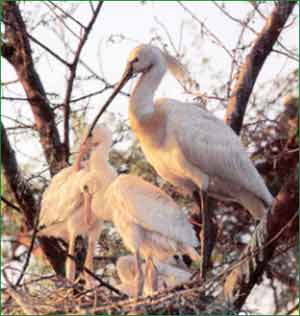 One of the most important Tourist Attractions in bharatpur includes the world famous bharatpur Bird Sanctuary. The bird sanctuary harbors some extraordinarily beautiful species of birds like egrets, painted stork, pelican, ibises and cormorants. Apart from the native and migratory birds, the sanctuary includes engendered animals like black buck, jackals, blue bull and otter.
One of the most important Tourist Attractions in bharatpur includes the world famous bharatpur Bird Sanctuary. The bird sanctuary harbors some extraordinarily beautiful species of birds like egrets, painted stork, pelican, ibises and cormorants. Apart from the native and migratory birds, the sanctuary includes engendered animals like black buck, jackals, blue bull and otter.bharatpur offers a wide selection of tourist locations. Some of the important tourist attractions of bharatpur are bharatpur Bird Sanctuary (Keoladeo Ghana National Park) and Lohagarh Fort . The tourist attraction in bharatpur is the world-renowned Keoladeo Ghana National Park or the bharatpur Bird Sanctuary.bharatpur, located in the northwestern state of Rajasthan is ideally referred to as the Ornithologists Paradise and a destination for ecotourism. With the arrival of the migratory birds in the park tourists and bird lovers flock to bharatpur. The best time to visit bharatpur is during the winter months from October to February when the migratory birds come to visit this park from all over the globe. Stretching over 29 sq km of kadam forests, grasslands and shallow lakes, bharatpur was created by the Maharaja of bharatpur in the 19th century by diverting water from an irrigation canal. Though initially a shooting preserve, it was given the status of a bird sanctuary in 1956. Upgraded to a national park in 1982, the area today ranks as one of the best waterbirds preserves in the world- and it is a World Heritage Site. bharatpur bird sanctuary harbors some of India's richest birdlife, including the gorgeous shocking-pink tinted painted stork, several species of cormorants, egrets, pelicans, ibises, cranes, ducks and geese. One can see over 350 species of birds, both native as well as migratory. Among the latter, the highly endangered Siberian Cranes, which come to nest in winter, are the rarest. bharatpur is the Siberian Crane's only known wintering ground in India; at last count, only 2 cranes nested at the park. In addition to the birds, Keoladeo is home to a wide range of mammal and reptile species, including deer, jackals, black buck, fishing cats, otters and blue bulls. Park Trails:In bharatpur Bird Sanctuary, there are well-defined forest trails, which can easily be covered on foot or on a cycle. Rickshaws can be hired too. Boat trips at dawn or dusk will be a memorable experience. Keoladeo National Park 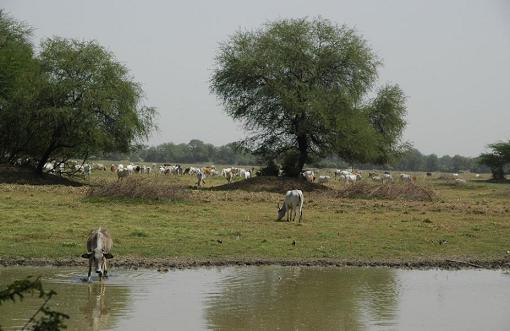 The Keoladeo National Park or Keoladeo Ghana National Park formerly known as the bharatpur Bird Sanctuary in Rajasthan, India is a famous avifauna sanctuary that sees (or saw) thousands of rare and highly endangered birds such as the Siberian Crane come here during the winter season. Over 230 species of birds are known to have made the National Park their home. It is also a major tourist centre with scores of ornithologists arriving here in the hibernal season. It was declared a protected sanctuary in 1971. It is also a declared World Heritage Site.
The Keoladeo National Park or Keoladeo Ghana National Park formerly known as the bharatpur Bird Sanctuary in Rajasthan, India is a famous avifauna sanctuary that sees (or saw) thousands of rare and highly endangered birds such as the Siberian Crane come here during the winter season. Over 230 species of birds are known to have made the National Park their home. It is also a major tourist centre with scores of ornithologists arriving here in the hibernal season. It was declared a protected sanctuary in 1971. It is also a declared World Heritage Site.
Fauna The sanctuary hosts a small wintering population of the rare Siberian Cranes. Other species include the ruddy shelducks, gulls, northern shovelers, northern pintails, coots, garganey, tufted ducks and common pochard. Lohagarh Fort 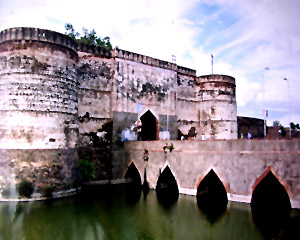 Lohagarh Fort (Iron fort) is situated at bharatpur in Rajasthan, India. It was constructed by bharatpur Jat rulers. Maharaja Suraj Mal used all his power and wealth to a good cause, and built numerous forts and palaces across his kingdom, one of them being the Lohagarh Fort(Iron fort), which was one of the strongest ever built in Indian history. The inaccessible Lohagarh fort could withstand repeated attacks of British forces led by Lord Lake in 1805 when they laid siege for over six weeks. Having lost over 3000 soldiers, the British forces had to retreat and strike a compromise with the bharatpur ruler. Of the two gates in the fort, one in the north is known as Ashtdhaatu (eight metalled) gate while the one facing the south is called Chowburja gate.
It is very different from the other forts in Rajasthan state, there is no flamboyance associated to fort but it generates an aura of strength and magnificence. The fort is surrounded with moat which was previously filled with water to ward off the enemy attacks. The sandy ramparts were strengthened by sandy battlements, thus the enemy guns proved of no avail.
Lohagarh Fort (Iron fort) is situated at bharatpur in Rajasthan, India. It was constructed by bharatpur Jat rulers. Maharaja Suraj Mal used all his power and wealth to a good cause, and built numerous forts and palaces across his kingdom, one of them being the Lohagarh Fort(Iron fort), which was one of the strongest ever built in Indian history. The inaccessible Lohagarh fort could withstand repeated attacks of British forces led by Lord Lake in 1805 when they laid siege for over six weeks. Having lost over 3000 soldiers, the British forces had to retreat and strike a compromise with the bharatpur ruler. Of the two gates in the fort, one in the north is known as Ashtdhaatu (eight metalled) gate while the one facing the south is called Chowburja gate.
It is very different from the other forts in Rajasthan state, there is no flamboyance associated to fort but it generates an aura of strength and magnificence. The fort is surrounded with moat which was previously filled with water to ward off the enemy attacks. The sandy ramparts were strengthened by sandy battlements, thus the enemy guns proved of no avail.Some interesting monuments in the fort are Kishori Mahal, Mahal Khas and Kothi Khas. Moti Mahal and towers like Jawahar Burj and Fateh Burj were erected to commemorate the victory over the Mughals and the British army . The Gateway has paintings of huge elephants. Lohagarh fort or the Iron fort was built in the early 18th century by the Jat ruler, Maharaja Suraj Mal. It is believed that it took nearly twenty years for the fort to be completed. The construction work of the fort started in the year 1730 when Maharaja Badan Singh, the father of Maharaja Surajmal was the ruler of bharatpur. By the time the construction work of the fort got completed in the year 1750, Maharaja Surajmal had taken over the throne. It is said that since its inception, Iron Fort was never invaded. The Lohagarh fort is a living testimony to the chivalry and bravery of the Jat rulers of bharatpur. Due to its impregnable defenses the fort came to be known by name of Lohagarh. The Lohagarh fort was surrounded and protected by deep moats. Though Lohagarh fort lacks the flamboyance of other forts of the region but its strength and magnificence is matchless. Some fascinating monuments in the fort are Kishori Mahal, Mahal Khas, Moti Mahal and Kothi Khas. Suraj Mal built the Jawahar Burj and Fateh Burj inside the fort to commemorate his victories over the Mughals and the British. There is an Ashtadhatu (eight-metal) gateway, having paintings of huge elephants. Because of all these abovementioned qualities and features the Lohagarh fort was able to thwart many British attacks. The British laid siege to the Lohagarh fort four times but had to raise the siege on all occasions. The Lohagarh Fort in bharatpur today houses an extensive museum. The tourists can go there to see articles like swords, daggers, guns, double barrel guns, long barrel guns, daggers, safety shields and revolvers apart from antiques like hunted cubs, bear kids, hunted tigers, deer, wood articles, jewelry boxes, hand fans, stone vessels, dresses and ornaments. bharatpur Government Museum 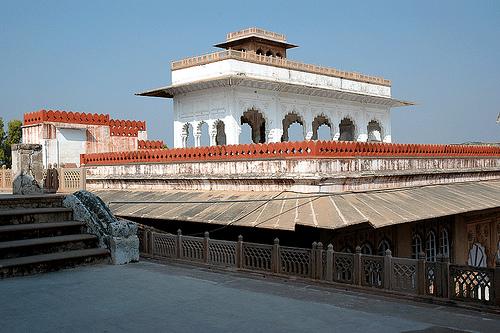 bharatpur Government Museum Located in the centre of the famous Lohagarh Fort, the bharatpur Museum houses a rich collection of archaeological wealth of the nearby areas as well as from the old bharatpur State.
The huge palatial building Kachahari kalan, once the administrative block of the rulers of bharatpur state, was converted into a Museum in 1944 AD. Later on, the Kamra Khas (personal chamber) building on the first floor was added to the museum. It exhibits sculptures found during the escavation of old villages e.g. Noh, Mallah, Bareh, Bayana etc. ranging from the Kushan period (Ist century A.D.) to 19th century A.D. Weapons used in battles in the medieval period the Jat rulers, paintings, manuscripts, zoological specimens, localart and carft that was once bharatpur.
The Art Gallery of the museum has specimens of miniature paintings on leaves of the peepal tree, mica and old lithopapers alongwith the paintings of the Maharajas of bharatpur. On the upper stroy one section consists of various tyupes of guns & miniature canons used during 18th centrurry A.D. Called 'Chaddra'.
These miniature canons - two sets of eleven each, were used by Maharaja Sawai Jawahar Singh in the battle while passing through the Jaipur territory on his return from a pilgrimage to Pushkar. The whole museum has been divided into the following sections : 1. Archaeology 2. Armoury 3. Arts,Crafts and Industry 4. Children Gallery 5. Miscellaneous .
bharatpur Government Museum Located in the centre of the famous Lohagarh Fort, the bharatpur Museum houses a rich collection of archaeological wealth of the nearby areas as well as from the old bharatpur State.
The huge palatial building Kachahari kalan, once the administrative block of the rulers of bharatpur state, was converted into a Museum in 1944 AD. Later on, the Kamra Khas (personal chamber) building on the first floor was added to the museum. It exhibits sculptures found during the escavation of old villages e.g. Noh, Mallah, Bareh, Bayana etc. ranging from the Kushan period (Ist century A.D.) to 19th century A.D. Weapons used in battles in the medieval period the Jat rulers, paintings, manuscripts, zoological specimens, localart and carft that was once bharatpur.
The Art Gallery of the museum has specimens of miniature paintings on leaves of the peepal tree, mica and old lithopapers alongwith the paintings of the Maharajas of bharatpur. On the upper stroy one section consists of various tyupes of guns & miniature canons used during 18th centrurry A.D. Called 'Chaddra'.
These miniature canons - two sets of eleven each, were used by Maharaja Sawai Jawahar Singh in the battle while passing through the Jaipur territory on his return from a pilgrimage to Pushkar. The whole museum has been divided into the following sections : 1. Archaeology 2. Armoury 3. Arts,Crafts and Industry 4. Children Gallery 5. Miscellaneous .Timing : 10 A. M. to 4.30 P.M. Closed : Friday and gazetted holidays. The huge palatial building Kachahari kalan, once the administrative block of the rulers of bharatpur state, was converted into a Museum in 1944 AD. Later on, the Kamra Khas (personal chamber) building on the first floor was added to the museum. It exhibits sculptures found during the escavation of old villages e.g. Noh, Mallah, Bareh, Bayana etc. ranging from the Kushan period (Ist century A.D.) to 19th century A.D. Weapons used in battles in the medieval period the Jat rulers, paintings, manuscripts, zoological specimens, localart and carft that was once bharatpur. The Art Gallery of the museum has specimens of miniature paintings on leaves of the peepal tree, mica and old lithopapers alongwith the paintings of the Maharajas of bharatpur. On the upper stroy one section consists of various tyupes of guns & miniature canons used during 18th centrurry A.D. Called 'Chaddra'. These miniature canons - two sets of eleven each, were used by Maharaja Sawai Jawahar Singh in the battle while passing through the Jaipur territory on his return from a pilgrimage to Pushkar. The whole museum has been divided into the following sections : 1. Archaeology 2. Armoury 3. Arts,Crafts and Industry 4. Children Gallery 5. Miscellaneous Entry Fee : RS. 3/- THE PALACE It is a fine blend of Mughal and Rajput architecture, built in various phases by different Maharajas. The magnificent apartments are richly decorated with patterned floor tiles with exquisite intricate designs. The museum occupies the main central wing depicting collections dating back to 2nd century, which reflect the art and skill of the region. DEEG TOWN 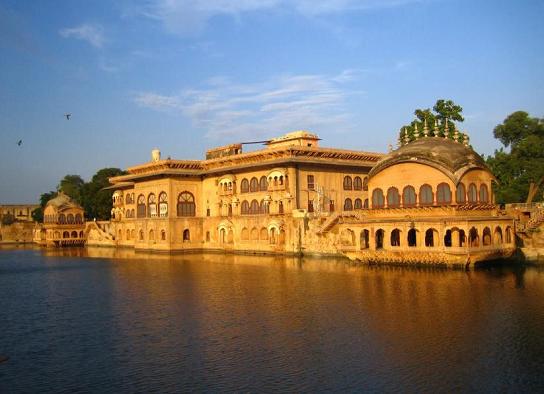 Location : 34 km from bharatpur in Rajasthan, India.
Location : 34 km from bharatpur in Rajasthan, India. Built By : Badan Singh in 1722 AD Famous For : Deeg Fort Other Highlights : Magnificent Palaces and Mughal Gardens History Of Deeg : Deeg is a city and a municipality in bharatpur district in the state of Rajasthan, India. It is situated in the north of bharatpur at a distance of 32 km, and 98 km (61 miles) North of Agra. Deeg comes under THE BIG PARIKRMA MARG of Lord Krishna which was started from Goverdhan, just only 12 km. far from deeg. It is an ancient town. It finds mention in Skanda Purana as "Dirgha" or "Dirghapur". Deeg was the first capital of the newly carved out Jat state of bharatpur, when Badan Singh was proclaimed its ruler in 1722. In 1730, the Maharaja Suraj Mal erected the strong fortress of Deeg. After Suraj Mal moved the capital to bharatpur, Deeg became the second capital of the rulers of bharatpur princely state. It is known for its number of forts, palaces, gardens and fountains. It is an ancient town. It finds mention in Skanda Purana as "Dirgha" or "Dirghapura". Deeg was the first capital of the newly carved out Jat state of bharatpur, when Badan Singh was proclaimed its ruler in 1722. In 1730, the Maharaja Suraj Mal erected the strong fortress of Deeg. After Suraj Mal moved the capital to bharatpur, Deeg became the second capital of the rulers of bharatpur princely state. It is known for its number of forts, palaces, gardens and fountains. Badan Singh ( 1722 - 1756 AD) after assuming the throne consolidated the headship of the tribe and thereby became the virtual founder of the Jat house at bharatpur. The credit of commencing the urbanization of Deeg also goes to him. It was he who selected this spot as the headquarters of his newly established Jat kingdom. Historically, Deeg is associated with the raise of the Jat peasants under the leadership of Rajaram (AD 1686-88), Bhajja Singh (AD 1688-98) and Chudaman (AD 1695-1721). After the death of Chudaman, Badansingh (AD 1722-56) consolidated his authority over several districts and became the virtual founder of the Jat rule at bharatpur. He is credited with transforming Deeg into a flourishing town with beautiful buildings, palaces and gardens. Surajmal (AD 1756-63), the son and successor of Badansingh was the greatest ruler and during his rule the power of clan reached its zenith. Fairs Now a days Deeg is famous for the three-day fair held in the month of September, when the forts of Deeg are brought to liveliness. Deeg has various kinds of palaces, the most famous among them is "Sawan-Bhadon". The palace has a hollow ceiling with rolling iron spheres in it; when water is made to flow into the ceiling, these spheres collide with each other and produce a sound like raining clouds Gopal Bhawan, Deeg Palace 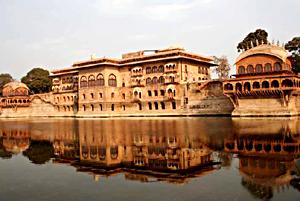 Gopal Bhawan is the largest and most admirable of all buildings in the Deeg palace. The name Gopal depicts the respect and devotion of the Jat rulers for Lord Krishna, the mythological hero of Braj. Gopal Bhawan is note worthy because of its creative setting and admirable architecture. It is one of the world's most luxurious palace complexes.
Gopal Bhawan is the largest and most admirable of all buildings in the Deeg palace. The name Gopal depicts the respect and devotion of the Jat rulers for Lord Krishna, the mythological hero of Braj. Gopal Bhawan is note worthy because of its creative setting and admirable architecture. It is one of the world's most luxurious palace complexes. Suraj Mai, the ruler of bharatpur, at the zenith of his glory had built the fountain palace of Deeg which is known as the Bhawans. Of all the buildings in the palace, Gopal Bhawan is the most estimable one. This principal palace of Deeg was finished by the year 1745. In terms of grandeur of conception and beauty of details it has few equals and could compete well with other palaces of its contemporary Rajput princes. Stepping into the palace complex, one is bound to be overwhelmed by its sheer splendour. In architecture, Gopal Bhawan combines the elegance of Shah Jahan�s palaces with the vigorous structural design of the Rajputs. Gopal Bhawan�s reflected view in the Gopal Sagar Lake is stunning and ensures a visitor a wonderful image of a lifetime. Its structural beauties reflecting themselves into adjacent sheets of water create a unique charm in the surroundings. The interior set up of Gopal Bhawan is praise worthy too. It is relatively a modern set up with well lighted spacious rooms much in contrast to the royal residences of the middle ages. Though the palace is built in two storeys but in certain parts, it has three and even four storey. Gopal Bhawan is built in red sandstone and the foliated Hindu arches are evidence that Suraj Mai gave employment to the craftsmen who since the time of Aurangzeb had ceased to work at the Mughal court. The exceptional feature of the eastern doorway of Gopal Bhawan is the central projection covered with grand arches and well sculptured impressive pillars. Another attractive feature is the hall with arcaded balcony. The private apartments of the Gopal Bhawan occupy the north, east and west side of the building. The side-wings of the palace seem to have been planned as purely residential suites. In the main façade of the Gopal Bhawan there is a tank which has as many as fifteen fountains and flanked by two canals with jets planned along the angles of the facade. The most impressive component of the whole exterior is the western face of the building rising above the waters of the Gopal-Sagar and adorned with rows of overhanging kiosks and balconies in the sides. Once, the roof terrace of the building was surmounted by a chhatri with hipped roof flattened at the ridge. The absence of the chhatri has somewhat lessened the grace of this noble work of art. Hardev Bhawan, Deeg Palace 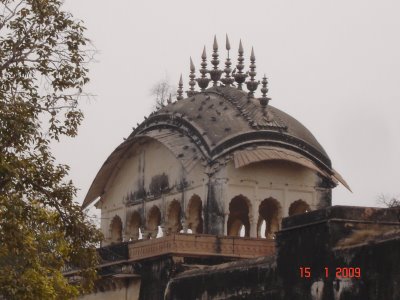 The Hardev Bhawan in Deeg Palace, Rajasthan lies immediately at the back of Suraj Bhawan and forms a charming quadrangle around an attached inner garden. This kind of set up was very common with the royal houses of the Middle Ages especially during the time of the Mughals.
The Hardev Bhawan in Deeg Palace, Rajasthan lies immediately at the back of Suraj Bhawan and forms a charming quadrangle around an attached inner garden. This kind of set up was very common with the royal houses of the Middle Ages especially during the time of the Mughals. The corner position of Hardev Bhawan questions its chance of being an original part of the main Bhawan complex. It is most likely that this mansion was later rebuilt by Suraj Mai, the ruler of bharatpur according to his taste and need. Its northern wing was destroyed to have room for the Suraj Bhawan. However, the flipside portion of the building is original. The main block of Hardev Bhawan on the south is two storeyed and has an impressive position over looking the ornamental garden. The lower floor consists of a projecting central hall, faced with arches springing from a row of double pillars. Behind the front arches is an arched row of pillars running along the three sides of the internal group of four pillars roughly similar to those existing within the side wings of the Gopal Bhawan. The feature of an oblong corridor with raised floor and domed cell is analogous to those of Suraj Bhawan. A rectangular compartment with a verandah bordered by cells has been constructed on either hand of the hall. On the east a comfortable slope offer admission to the upper storey, that has a railed central terrace and two pillared dalans on either side. The rear part of the terrace of Hardev Bhawan is occupied by a crowning chhatri bearing a spiked curved-roof graced with miniature side-domes. A thin gallery, displayed with obliquely-cut jalis runs at the back of the upper floor. The position of the Hardev Bhawan implies that it was meant for noble families. The garden of Hardev Bhawan is strictly of a private nature suitable for ladies quarters. The jets studded in the four garden canals are very small and are modeled after the lotus-bud without any sculptured body. But whether this is original or a later alteration is difficult to guess. BENGAL CHAMBER It houses the dining room, and has sloping arches, with comfortable cushions along the outer edges forming the seating area. The walls of the royal Chess Room has trellis design and are painted in soft red Suraj Bhavan 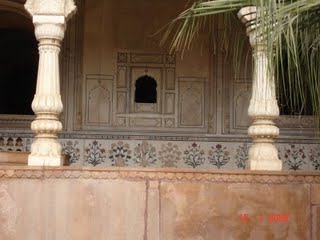 Suraj Bhavan is a single-storeyed palace situated inside the Deeg Fort in Deeg, a beautiful garden town located 32 km north of bharatpur in Rajasthan. It lies to the east of the main building, Gopal Bhavan.
Suraj Bhavan was named after the Jat king, Suraj Mal who built this palace in the 18th century. The palace architecture has a strong influence of Mughal edifices.
Suraj Bhavan is a single-storeyed palace situated inside the Deeg Fort in Deeg, a beautiful garden town located 32 km north of bharatpur in Rajasthan. It lies to the east of the main building, Gopal Bhavan.
Suraj Bhavan was named after the Jat king, Suraj Mal who built this palace in the 18th century. The palace architecture has a strong influence of Mughal edifices. The palace is made of marble having fine floral carvings and is ornamented with semiprecious stones. Lotus fountains carved in the floor of the main hall and water channels and cascading water falls built in the verandas gives it a cooling effect during the summers. Deeg is about 152 km south-west of Delhi. Nearest airport is at Agra (54 km). Suraj Bhawan is named after Suraj Mai, the ruler of bharatpur and the builder of the Bhawans of Deeg palace. It is an attractive building of marble and the architectural treatment of the Suraj Bhawan bears similarity with the Mughal architectural pattern. The construction of Suraj Bhawan was started by Suraj Mai but after his death it was completed by his son Jawahar Singh. The building of Suraj Bhawan consists of a single storey and is devised as a square of 26.80 metres with a leveled roof. The marbles that has been used here belonged to more than one royal building of the Mughals, because the slabs employed in the walls do not always match in size and texture. Generally this building is supposed to have the marble slabs of the royal school for the princesses in the Red Fort, Delhi, which probably was one of the many victims of Jawahar`s fury. In addition to this the Jats have also used some fresh marbles which did not belong to any previous edifice. It is possibly due to the death of Jawahar Singh the encasement of the structure remained unfinished. The idea to cover it with white marble more probably was an after-thought, for certain pavements, its pedestal, major segment of the western face and a huge number of roof space and brackets are still in sandstone. In order to give them the resemblance of marble, with the exception of the pedestal, they have been covered with a superior mixture of lime plaster. Each face of Suraj Bhawan has a verandah with five openings and rooms nearby at the corner which have dome like ceiling ornamented with a single lotus similar to many Mughal buildings. The floor of every verandah is studded with a central tank containing jets to serve as an entity of beauty for the structure as well as for its dwellers. The main room of the building is lighted through windows and recesses of the corridors and this mitigates the monotony of the walls to a large extent. The curved ceilings of the corridors which are supported by semi-circular arches are an interesting feature of the Suraj Bhawan. The interior arrangements of the Suraj Bhawan are more like an exhibition area than a place of residence. This provision was mainly designed for the exclusive use of the ladies as a place for respite and leisure. The sandstone structure with a verandah and side-compartments on the east of this mansion has perhaps been put up to safeguard its architectural effect. The grace of the Suraj Bhawan is enhanced by tanks and gardens on either side, assisted by the features of Deeg architecture. NAND BHAVAN It is a larage audience hall. KRISHNA BHAVAN, and the ingeniously designed water works of KESHAV BHAVAN, with open twelve pillared pavilion are of great interest PURANA MAHAL It is the oldest palace, planned as a spacious rectangle encircled by compartments and chamber, it has a collection of some very fine Rajput and Mughal schools. Deeg Fort 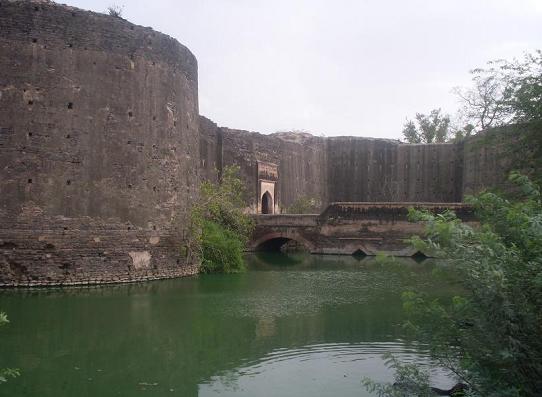 In the beautiful garden town of Deeg, lies the Deeg Fort built by the Raja Surajmal in the 18th century.
This majestic fort is surrounded by impressive moats and gateways. It has elegant palaces around the garden complex with fountains and enormous water bodies in the rear. The palaces within the fort include Gopal Bhavan, Suraj Bhavan, Nand Bhavan and Keshav Bhavan. These palaces form a quadrangle with a beautiful garden in the center. The garden is laid with flowerbeds and fountains.
In the beautiful garden town of Deeg, lies the Deeg Fort built by the Raja Surajmal in the 18th century.
This majestic fort is surrounded by impressive moats and gateways. It has elegant palaces around the garden complex with fountains and enormous water bodies in the rear. The palaces within the fort include Gopal Bhavan, Suraj Bhavan, Nand Bhavan and Keshav Bhavan. These palaces form a quadrangle with a beautiful garden in the center. The garden is laid with flowerbeds and fountains. The unique feature of the garden is that it holds about 2,000 fountains, which come to life twice every year, in February and September. The showers from the fountain give a feeling of monsoon. Most of the interiors of the fort are in a dilapidated condition, except the watchtower, which stands overlooking the city and the palace. Other attractions of the fort include a gun captured from Agra fort and obsolete cannon of Ahmad Shah Abdali. Braj The history of Braj Bhoomi dates back to as early as 600 B.C., ever since it has been associated with Lord Sri Krishna. Mythological literature specially, Shrimadbhagwat Mahapuran, Brahmavaivart Puran, Agni Puran and Garg Samhita contain elaborate descriptions of the extraordinary powers and activities of Lord Krishna at Braj, his birthplace. The Vedic literature of the Northern Era, like the Gopal Taapniya Upanishad, etc., also has descriptions of this holy land and its association with Sri Krishna. In fact, no other region of India has been described in such details since ancient times as Braj . bharatpur District is locate in Braj Area. |

